Greenland: Prelude
Posted August 25, 2015 by twj
Greenland
August 25, 2015
Hello Fellow Rider,
Over the years, I have been fortunate to travel the world using a variety of animate and inanimate conveyances.
I have flown on many fixed-wing aircraft, both propeller and jet, from a Boeing 747 to a Boeing DC 3 to an Embraer 190.
But today, something new.




